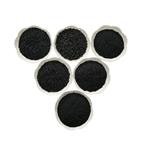
Carborundum
- Product NameCarborundum
- CAS409-21-2
- CBNumberCB00127188
-
MFCSi
Lewis structure
- MW40.1
- EINECS206-991-8
- MDL NumberMFCD00049531
- MOL File409-21-2.mol
Chemical Properties
| Melting point | 2700 °C (lit.) |
| Density | 3.22 g/mL at 25 °C (lit.) |
| bulk density | 0.069g/cm3 |
| refractive index | 2.6500 |
| solubility | Soluble in molten sodium hydroxide, potassium hydroxide and in molten iron. |
| form | nanopowder |
| color | Green |
| Specific Gravity | 3.22 |
| Resistivity | 107–200 (ρ/μΩ.cm) |
| Water Solubility | Soluble in molten alkalis (NaOH, KOH) and molten iron. Insoluble in water. |
| Hydrolytic Sensitivity | 1: no significant reaction with aqueous systems |
| Crystal Structure | Cubic, Sphalerite Structure - Space Group F(-4)3m |
| Merck | 14,8492 |
| Exposure limits | ACGIH: TWA 10 mg/m3; TWA 3 mg/m3; TWA 0.1 fiber/cm3 OSHA: TWA 15 mg/m3; TWA 5 mg/m3 NIOSH: TWA 10 mg/m3; TWA 5 mg/m3 |
| Stability | Stability |
| InChIKey | HBMJWWWQQXIZIP-UHFFFAOYSA-N |
| EWG's Food Scores | 3 |
| FDA UNII | WXQ6E537EW |
Safety
| Symbol(GHS) |

|
|||||||||
| Signal word | Danger | |||||||||
| Hazard statements | H350i | |||||||||
| Precautionary statements | P201-P202-P280-P308+P313-P405-P501 | |||||||||
| Hazard Codes | Xi | |||||||||
| Risk Statements | 36/37/38 | |||||||||
| Safety Statements | 26-36 | |||||||||
| OEB | B | |||||||||
| OEL | TWA: 10 mg/m3 (total) | |||||||||
| WGK Germany | 3 | |||||||||
| RTECS | VW0450000 | |||||||||
| TSCA | Yes | |||||||||
| HS Code | 28492000 | |||||||||
| Hazardous Substances Data | 409-21-2(Hazardous Substances Data) | |||||||||
| 発がん性評価について | ACGIH A2 | |||||||||
| NFPA 704: |
|

